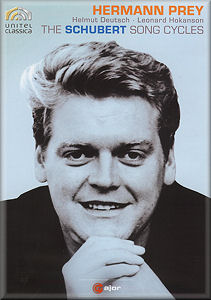 |
 |
|


alternatively
AmazonUK
AmazonUS
|
Franz SCHUBERT (1797-1828)
The Song Cycles
Die Schöne Müllerin [63:00]
Schwanengesang [54:00]
Winterreise [74:00]
Stationen eines Interpreten: A Documentary on Hermann Prey
[37:00]
 Hermann Prey (baritone) Hermann Prey (baritone)
Leonard Hokanson, Helmut Deutsch (piano)
Film director: Franz Kabelka
rec. Die Schöne Müllerin: 17-23 February 1986, ORF Studio, Vienna; Schwanengesang,
1-5 November 1984, ORF Studio, Vienna; Winterreise, 18-21 November 1986,
Schechacher Hof, Vienna
Sound format: PCM stereo, Dolby Digital 5.1
Picture format: 4:3
Picture standard: NTSC
Subtitles: EN, FR, ES
Region code: 0
 UNITEL CLASSICA 700208 UNITEL CLASSICA 700208  [252:00] [252:00] 
|
|
|
Schubert’s lieder is one of my favourite parts of the classical
repertory,
and I have to confess that I’m an inveterate fan of Dietrich Fischer-Dieskau
singing these works. I have dozens of his recordings, from the early EMI recitals
to the “complete” DG set, as well as many of his various versions
of Winterreise and the other song-cycles, together with many of the more
recently released radio performances.
But a few years ago, by way of Deutsche Grammophon’s download site, I picked
up a set of Hermann Prey’s recordings on the cheap. Not being familiar
with his works - he had never come into my radar - I was impressed by how wonderful
his voice was and how rich his technique. Unfortunately, while he recorded a
fair amount of lieder, his catalogue is nothing like that of Fischer-Dieskau;
while he recorded the three song-cycles, which appear on this DVD set, he recorded
few other lieder by Schubert.
Die Schöne Müllerin starts off this two-disc set, with Hermann
Prey and pianist Leonard Hokanson on a set made up to look like a bourgeois music
room. With furniture along the walls, windows looking out on painted backdrops,
and some “sun” streaming in, it is meant to look as though the two
just got together for some amiable music-making after a good Viennese lunch.
For Schwanengesang, the set is the same, but it is evening. While Prey
and Hokanson are well lit, the rest of the set is very dark at times. For Winterreise,
the setting is similar, but with more normal studio lighting. It’s daytime
again, and one can glimpse frost on the windows and snow on a tree outside.
Prey is natural and seems as though he’s singing for a few friends; he
embraces the camera, whose many tight shots keep this recording intimate. Though
these close-ups can be odd; during Ihr Bild, in Schwanengesang,
all but the first few seconds of the song feature a close-up of Prey, which zooms
in slowly during the first minutes to maintain nothing but his head on screen;
this technique is used with other songs too. While his smiles sometimes seem
forced, it is clear that he truly loves and understands this music, and he is
able to express this in the subtle manner in which he approaches it. Yet he can
be very strong and forceful, such as when singing the powerful Der Doppelgänger,
in Schwanengesang. Here, Prey shows the dark side of this music, and does
so with violent expressiveness.
While Prey seems very comfortable, Hokanson is one of those pianists who looks
as though he’s working hard when he plays. He has sheet music for the songs
on his piano as he plays, which is a bit disturbing. I understand that musicians
may need this in concert, but you’d think that for a recording like this
they’d be able to play from memory. During Winterreise, Helmut Deutsch
seems more absorbed in the music than Hokanson, hunched over his piano, though
he, too, needs to have the score on his piano.
The sound is both good and mediocre. The first piano notes in Die Schöne
Müllerin show that the piano didn’t record well; it booms a bit,
sounds muddy when alone, and is, at times, a bit too loud compared with Prey’s
voice. It’s better in the stereo mix than in the faux-5.1 version. The
piano sound is better for Winterreise. Prey, however, sounds excellent;
his voice comes through clearly and the smooth character of his singing is evident
with each word. At times, though, the sound is very strange. In Der Atlas,
the second song of Schwanengesang, Prey’s voice suddenly sounds
strident, as though there were a problem with the recording. It is much louder
than the previous song in that cycle (and the songs in Die Schöne Müllerin),
and sounds as though he was miked differently. The rest of the songs sound normal,
though occasionally, in the louder sections, the levels go into the red.
So what about the performances? Prey is pretty darned good in these song-cycles.
I’ve heard many singers tackle them, and Prey is one of those who sings
these works without exaggeration or misplaced mannerisms. He may seem a bit wooden
when singing, but this betrays a certain stability in his approach. While he
can be forceful when necessary, and lyrical when the music calls for it, he seems
to find the right balance for most of the songs. This is a wonderful set, with
all three of the cycles recorded in similar circumstances and close together,
though it’s a shame they weren’t recorded a decade earlier, when
Prey was truly in his prime.
For those unfamiliar with Hermann Prey, this is a wonderful way to get to know
this great singer. For those who know his work, this set is a must-have. Prey
shows here that he can rival the best.
Kirk McElhearn
|
|

